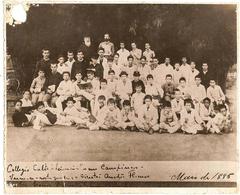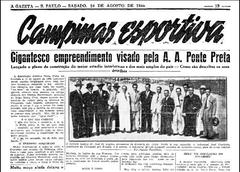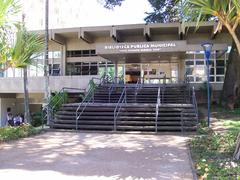Cemitério da Saudade: Visiting Hours, Tickets, and Historical Significance in Campinas, Brazil
Date: 03/07/2025
Introduction
Cemitério da Saudade, nestled in the city of Campinas, São Paulo, is far more than a traditional burial ground. Established between 1880 and 1881, it stands today as an open-air museum—a testament to Campinas’ rich historical evolution, architectural splendor, and multicultural identity. This comprehensive guide provides everything travelers, history enthusiasts, and cultural tourists need to know about visiting the site: its origins, artistic treasures, accessibility, guided tours, and practical travel tips. Discover why Cemitério da Saudade is a must-see landmark for anyone seeking to understand the soul of Campinas.
Table of Contents
- Introduction
- Origins and Historical Background
- Architectural and Artistic Heritage
- Notable Figures and Local Legends
- Visitor Information
- Social and Cultural Significance
- Preservation, Restoration, and Community Engagement
- Frequently Asked Questions (FAQ)
- Practical Visitor Tips
- Conclusion and Recommendations
- References and Further Reading
Origins and Historical Background
Cemitério da Saudade was inaugurated in 1881 to accommodate the needs of a rapidly growing Campinas, replacing the earlier municipal cemetery in Vila Industrial. Initially called “Cemitério do Fundão,” it absorbed various smaller cemeteries run by religious orders, eventually becoming the city’s principal burial site. Its foundation is commemorated every year on February 7th, now celebrated as the “Dia do Patrimônio Cultural Funerário” (Funerary Cultural Heritage Day), underscoring its importance in the city’s collective memory (G1 Globo Campinas).
Architectural and Artistic Heritage
Covering approximately 181,500 square meters, Cemitério da Saudade is renowned for its eclectic funerary architecture and monumental art. The cemetery features a remarkable mix of neoclassical, art nouveau, art déco, and modernist styles, reflecting the artistic trends of the late 19th and early 20th centuries—especially during Campinas’ coffee boom. Notable contributions came from Italian sculptors like Giuseppe Tomagnini, as well as local artisans such as the Velez Family and the Coluccini Brothers (Arte Funerária Brasil).
The grounds are divided into organized blocks and avenues, with symbolic prominence given to family mausoleums and religious iconography. Over 7,000 sculptures and monuments adorn the cemetery, making it a national reference point for funerary art.
Notable Figures and Local Legends
Cemitério da Saudade is the final resting place for many of Campinas’ most notable personalities:
- Francisco Glicério: Influential politician and abolitionist.
- Hercules Florence: Pioneer of photography in Brazil.
- Campos Sales: Former President of Brazil.
- Bento Quirino, Baron Geraldo de Rezende, and Baron of Atibaia: Prominent coffee barons whose mausoleums illustrate the city’s elite history.
- Toninho Milagreiro and the “Três Anjinhos”: Figures associated with local folklore and miraculous legends (Campinas.com.br).
The site also houses the unique Santuário do Seu Tranca Ruas das Almas, a shrine dedicated to the Umbanda entity Seu Tranca Ruas—an exceptional example of spiritual diversity within Brazilian cemeteries (ACidadeOn).
Visitor Information
Visiting Hours and Admission
- Opening Hours: Daily from 7:00 AM to 5:00 or 6:00 PM (check local notices for holiday schedules).
- Admission: Free for all visitors (Find a Grave).
Accessibility
Main avenues and pathways are wheelchair accessible, though some older sections may have uneven terrain due to age and weathering. The cemetery is equipped with ramps and adapted paths for visitors with mobility challenges.
Guided Tours
Guided tours—such as the popular “Saudade e Suas Vozes”—are available through the Campinas tourism office and local cultural organizations. These typically last 2.5 to 3 hours, covering the cemetery’s grand mausoleums, historical graves, and folklore. Night walks and thematic tours may also be available, especially during Funerary Heritage Day (Civitatis; ACidadeOn).
Getting There and Nearby Attractions
Cemitério da Saudade is centrally located at Avenida da Saudade, 500, in the Swift/Ponte Preta district. It is easily accessible by public transport (bus lines 131, 132, and 133) and car (street parking available nearby). The site is close to other cultural attractions, including the Museu da Cidade, the Catedral Metropolitana de Campinas, Estádio Moisés Lucarelli, and local cafés.
Social and Cultural Significance
Beyond its function as a cemetery, Cemitério da Saudade is a living archive of Campinas’ social and religious history. Its distinct sections—such as Curas D’ars (yellow fever victims), São Miguel e Almas (Black Catholics), Terceira Ordem do Carmo and Santíssimo Sacramento (white Catholics)—reflect the city’s historical stratification and ethnic diversity (Arte Funerária Brasil). The site serves as a locus for community rituals, annual commemorations, and educational activities, anchoring collective memory and promoting dialogue between cultures.
Preservation, Restoration, and Community Engagement
Recognized as cultural heritage in 2003, the cemetery has benefited from restoration projects—most notably a R$ 6.9 million revitalization in 2025 addressing internal roads and ecological sustainability (Sampi Campinas). Community-driven programs, led by local historians and educators, foster ongoing cataloging, oral history collection, and public awareness, ensuring the preservation of its unique legacy.
Frequently Asked Questions (FAQ)
Q: What are the visiting hours for Cemitério da Saudade?
A: The cemetery is open daily from 7:00 AM to 5:00 or 6:00 PM.
Q: Is there an entrance fee?
A: No, admission is free.
Q: Are guided tours available?
A: Yes, both regular and thematic guided tours can be booked through the tourism office or local organizations.
Q: Is the cemetery wheelchair accessible?
A: Main pathways are accessible, though some sections may be uneven.
Q: Can I take photos?
A: Discreet photography for personal use is permitted, but photographing funerals or mourners is prohibited.
Practical Visitor Tips
- Dress Code: Wear comfortable, modest clothing and closed shoes.
- Best Time to Visit: Weekday mornings are quieter; All Souls’ Day offers cultural insight but is crowded.
- Weather: Campinas is subtropical; bring water, sunscreen, and insect repellent.
- Conduct: Maintain respectful behavior, especially during ceremonies or near shrines.
- Research: Download a map or use the Audiala app for self-guided tours and additional context.
Conclusion and Recommendations
Cemitério da Saudade is a profound testament to Campinas’ layered history, artistic achievements, and cultural diversity. Free to enter and accessible to all, it offers a contemplative, educational, and visually stimulating experience for both residents and visitors. Whether joining a guided tour, exploring the grounds independently, or attending cultural events, you’ll find that the cemetery connects the past and present in powerful ways.
To enrich your visit, check for special events like Funerary Cultural Heritage Day on February 7th, explore nearby cultural landmarks, and use dedicated resources such as the Audiala app for guided experiences. Cemitério da Saudade stands as one of Campinas’ most compelling destinations—a space where art, memory, and identity converge.





